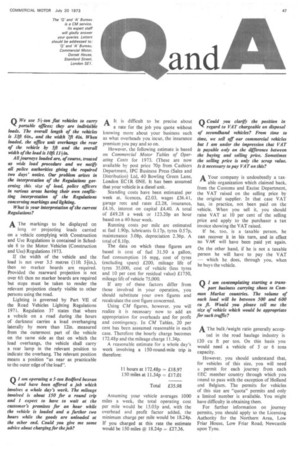Q We use 5+-ton flat vehicles to carry .< portable offices;
Page 49

If you've noticed an error in this article please click here to report it so we can fix it.
they are indivisible loads. The overall length of the vehicles is 33ft 6in, and the width 7/1 4in. When loaded, the office unit overhangs the rear of the vehicle by 5ft and the overall width of the load is la fl 1 1 fin.
All journeys loaded are, of course, treated as wide load procedure and we not all police authorities giving the required two days' notice. Our problem arises in the interpretation of the Regulations governing this size of load, police officers in various areas having their own conflicting interpretation of the Regulations concerning markings and lighting.
What is your interpretation of the current Regulations?
A The markings to be displayed on
long or projecting loads carried on a vehicle complying with Construction and Use Regulations is contained in Schedule 8 to the Motor. Vehicles (Construction and Use) Regulations 1973.
If the width of the vehicle and the load is not over 3.5 metres (lift
then no marker boards are required. Provided the rearward projection is not over 6ft then no marker boards are required but steps must be taken to render the relevant projection clearly visible to other persons using the road.
Lighting is governed by Part VII of the Road Vehicles Lighting Regulations 1971. Regulation 37 states that where a vehicle on a road during the hours of darkness carries a load overhanging laterally by more than 12in. measured from the outermost part of the vehicle on the same side as that on which the load overhangs, the vehicle shall carry a rear lamp in the relevant position to indicate the overhang. The relevant position means a position "as near as practicable to the outer edge of the load".




































































































